Articles
- Page Path
- HOME > J Korean Acad Nurs > Volume 42(1); 2012 > Article
-
Original Article
- Violent Experiences and Coping among Home Visiting Health Care Workers in Korea
- In Sook Lee, Kwang Ok Lee, Hee Sun Kang, Yeon-Hwan Park
-
Journal of Korean Academy of Nursing 2012;42(1):66-75.
DOI: https://doi.org/10.4040/jkan.2012.42.1.66
Published online: February 29, 2012
1Professor, School of Nursing, Seoul National University, Seoul, Korea.
2Full-time lecturer, Department of Nursing, Sangmyung University, Cheonan, Korea.
3Associate Professor, School of Medicine, Chung-Ang University, Seoul, Korea.
4Associate Professor, School of Nursing, Seoul National University, Seoul, Korea.
- Address reprint requests to: Lee, Kwang Ok. Department of Nursing, Sangmyung University, 31 Sangmyungdae-gil, Dongnam-gu, Cheonan, Chungnam 330-720, Korea. Tel: +82-41-550-5430, Fax: +82-41-550-5545, kolee@smu.ac.kr
• Received: December 20, 2010 • Accepted: February 5, 2012
© 2012 Korean Society of Nursing Science
- 853 Views
- 11 Download
- 11 Crossref
Abstract
-
Purpose
- The purpose of this study was to explore violent experiences of home visiting health care workers in Korea.
-
Methods
- This study was a cross-sectional survey. Data were collected using self-report questionnaires from 1,640 health care workers. Data collection was done between September 1, 2009 and June 30, 2010.
-
Results
- Of the respondents, 70.6% had experienced work-related violence. Shouting (51.9%) was the most common verbal violence, followed by verbalizing sexual remarks to the health care workers (19.0%) and touching the hands (16.5%), the most common acts relating to sexual harassment. Of the respondents who had experienced violence, 50.9% told their peers about the incidents. However, the major reasons why they did not report these incidents was due to the fact that they felt it was useless to file reports and that they expected such incidents to occur as part of their job. The majority of the respondents (86.4%) wanted education on how to deal with such violence at work.
-
Conclusion
- The results of this study indicate that efforts should be made to increase awareness and to minimize violence in the workplace. Also, educational programs should be designed to improve knowledge and to prevent workplace violence.
- 1. Anderson C. Workplace violence: Are some nurses more vulnerable? Issues in Mental Health Nursing. 2002;23:351–366. http://dx.doi.org/10.1080/01612840290052569.ArticlePubMed
- 2. Anderson L., Fitzgerald M., Luck L. An integrative literature review of interventions to reduce violence against emergency department nurses. Journal of Clinical Nursing. 2010;19:2520–2530. http://dx.doi.org/10.1111/j.1365-2702.2009.03144.x.ArticlePubMed
- 3. Bimenyimana E., Poggenpoel M., Myburgh C., van Niekerk V. The lived experience by psychiatric nurses of aggression and violence from patients in a Gauteng psychiatric institution. Curationis. 2009;32(3):4–13.
- 4. Canton A.N., Sherman M.F., Magda L.A., Westra L.J., Pearson J.M., Raveis V.H., et al. Violence, job satisfaction, and employment intentions among home healthcare registered nurses. Home Healthcare Nurse. 2009;27(6):364–373. http://dx.doi.org/10.1097/01.NHH.0000356828.27090.bd.ArticlePubMed
- 5. Chapman R., Styles I., Perry L., Combs S. Examining the characteristics of workplace violence in one non-tertiary hospital. Journal of Clinical Nursing. 2010;19(3-4):479–488. http://dx.doi.org/10.1111/j.1365-2702.2009.02952.x.ArticlePubMed
- 6. Chen W.C., Hwu H.G., Wang J.D. Hospital staff responses to workplace violence in a psychiatric hospital in Taiwan. International Journal of Occupational and Environmental Health. 2009;15(2):173–179.ArticlePubMed
- 7. Franz S., Zeh A., Schablon A., Kuhnert S., Nienhaus A. Aggression and violence against health care workers in Germany: A cross sectional retrospective survey. BMC Health Services Research. 2010;10(51):1–8. http://dx.doi.org/10.1186/1472-6963-10-51.PubMedPMC
- 8. Gacki-Smith J., Juarez A.M., Boyett L., Homeyer C., Robinson L., MacLean S.L. Violence against nurses working in US emergency departments. Journal of Healthcare Protection Management. 2010;26(1):81–99. http://dx.doi.org/10.1097/NNA.0b013e3181ae97db.PubMed
- 9. Hegney D., Tuckett A., Parker D., Eley R.M. Workplace violence: Differences in perceptions of nursing work between those exposed and those not exposed: A cross-sector analysis. International Journal of Nursing Practice. 2010;16(2):188–202. http://dx.doi.org/10.1111/j.1440-172X.2010.01829.x.ArticlePubMed
- 10. Isaksson U, Graneheim UH, Åström S. Female caregivers' experiences of exposure to violence in nursing homes. Journal of Psychiatric and Mental Health Nursing. 2009;16(1):46–53. http://dx.doi.org/10.1111/j.1365-2850.2008.01328.x.ArticlePubMed
- 11. Kim M.J. Kinds of workplace violence for hospital nurses and their reaction after being damaged. 2008;Seoul, Hanyang University. Unpublished Master's thesis.
- 12. Kwon H.J., Kim H.S., Choe K.S., Lee K.S., Sung Y.H. A study on verbal abuse experienced at medical centers. Clinical Nursing Research. 2007;13(2):113–124.
- 13. Lazarus R.S., Folkman S. Stress, appraisal and coping. 1984;New York, NY, Springer Publication Company.
- 14. Lee E. A study on awareness of sexual harrassment in the workplace examined through male sexual culture with focus on male office workers in their thirties. 2010;Seoul, Ewha Womans University. Unpublished Master's thesis.
- 15. Ministry for Health, Welfare and Family Affairs. The guide of tailored home visiting health service for 2009. 2008;Seoul, MHWFA.
- 16. Park J.S., Oh Y.J. The effect of case management for clients with hypertension, DM registered in customized home visiting health care services. Journal of Korean Academy of Public Health Nursing. 2010;24(1):135–150.
- 17. Pich J., Hazelton M., Sundin D., Kable A. Patient-related violence against emergency department nurses. Nursing & Health Sciences. 2010;12(2):268–274. http://dx.doi.org/10.1111/j.1442-2018.2010.00525.x.Article
- 18. Roche M., Diers D., Duffield C., Catling-Paull C. Violence toward nurses, the work environment, and patient outcomes. Journal of Nursing Scholarship: an Official Publication of Sigma Theta Tau International Honor Society of Nursing / Sigma Theta Tau. 2010;42(1):13–22. http://dx.doi.org/10.1111/j.1442-2018.2010.00525.x.
- 19. Rodríguez-Acosta R.L., Myers D.J., Richardson D.B., Lipscomb H.J., Chen J.C., Dement J.M. Physical assault among nursing staff employed in acute care. Work: a Journal of Prevention, Assessment, and Rehabilitation. 2010;35(2):191–200. http://dx.doi.org/10.3233/WOR-2010-0971.Article
- 20. Yun J.S. A study on job satisfaction and violence experience by ED nurses. 2004;Ulsan, University of Ulsan. Unpublished Master's thesis.
- 21. Zampieron A., Galeazzo M., Turra S., Buja A. Perceived aggression towards nurses: Study in two Italian health institutions. Journal of Clinical Nursing. 2010;19:2329–2341. http://dx.doi.org/10.1111/j.1365-2702.2009.03118.x.ArticlePubMed
REFERENCES
Figure & Data
REFERENCES
Citations
Citations to this article as recorded by 

- Improving Local Government Performance Through the Use of Contract Workers: A Case From South Korea
Naon Min, Jongseong Lee
Review of Public Personnel Administration.2025; 45(1): 172. CrossRef - Classifying Studies on Workplace Violence for Visiting Nurses Using the Social-Ecological Model: A Scoping Review
Eunjoo Kim, Juna Lee
Journal of Community Health Nursing.2024; 41(2): 96. CrossRef - Workplace Violence Experienced by Personal Care Workers in a District in Seoul, Republic of Korea: A Comparison Study with Office and Service Workers
Mi-Suk Cho, Kyoung-Bok Min, Jin-Young Min
Healthcare.2024; 12(3): 320. CrossRef - Needs assessment of a home-visit safety management training program for visiting nurses
Eunjoo Kim, Hyori Kim
The Journal of Korean Academic Society of Nursing Education.2023; 29(2): 138. CrossRef - Prevalence of workplace violence against registered nurses and their perceptions of relevant management systems in acute care hospitals
Seungmi Park, Eunju Kwak, Ye-Won Lee, Eun-Jun Park
The Journal of Korean Academic Society of Nursing Education.2023; 29(3): 319. CrossRef - Experience of Violence and Factors Influencing Response to Violence Among Emergency Nurses in South Korea: Perspectives on Stress-Coping Theory
Seung-Yi Choi, Hyunlye Kim, Kwang-Hi Park
Journal of Emergency Nursing.2022; 48(1): 74. CrossRef - Mediating Effects of Psychological States on Work Performance of Visiting Nurses According to COVID-19 Workplace Quarantine Measures: A Multi-Group Path Analysis Study
Jee-Hyun Hwang
International Journal of Environmental Research and Public Health.2021; 19(1): 444. CrossRef - Difficulties and Coping Experienced by Advanced Practice Nurses in Home Health Nursing Field
Moon-Sook Hwang, Hak Young Park, Soo Jung Chang
Journal of Korean Academy of Community Health Nursing.2020; 31(2): 143. CrossRef - Who Cares for Visiting Nurses? Workplace Violence against Home Visiting Nurses from Public Health Centers in Korea
Eunjoo Kim, Heeseung Choi, Ju Young Yoon
International Journal of Environmental Research and Public Health.2020; 17(12): 4222. CrossRef - Workplace Bullying, Job Stress, Intent to Leave, and Nurses’ Perceptions of Patient Safety in South Korean Hospitals
Hyunjin Oh, Dong-choon Uhm, Young Joo Yoon
Nursing Research.2016; 65(5): 380. CrossRef - The Relation between Interpersonal Attitude and Communication Competence of New Visiting Nurses in Community Health Center
Seung Joo Lim, Eun A Park
Korean Journal of Occupational Health Nursing.2014; 23(2): 115. CrossRef
Violent Experiences and Coping among Home Visiting Health Care Workers in Korea
Violent Experiences and Coping among Home Visiting Health Care Workers in Korea
General Characteristics of the Participants (N=1,640)
Experience of Violence (multiple responses) (N=1,640)
Experience of Violence by General Characteristics (N=1,158)
*p<.05; **p<.01
Action Taken after Violence Occurred (N=1158)
Reasons for not Reporting the Violence (N=843)
Table 1
General Characteristics of the Participants (N=1,640)
Table 2
Experience of Violence (multiple responses) (N=1,640)
Table 3
Experience of Violence by General Characteristics (N=1,158)
*
Table 4
Action Taken after Violence Occurred (N=1158)
Table 5
Reasons for not Reporting the Violence (N=843)
 KSNS
KSNS
 E-SUBMISSION
E-SUBMISSION
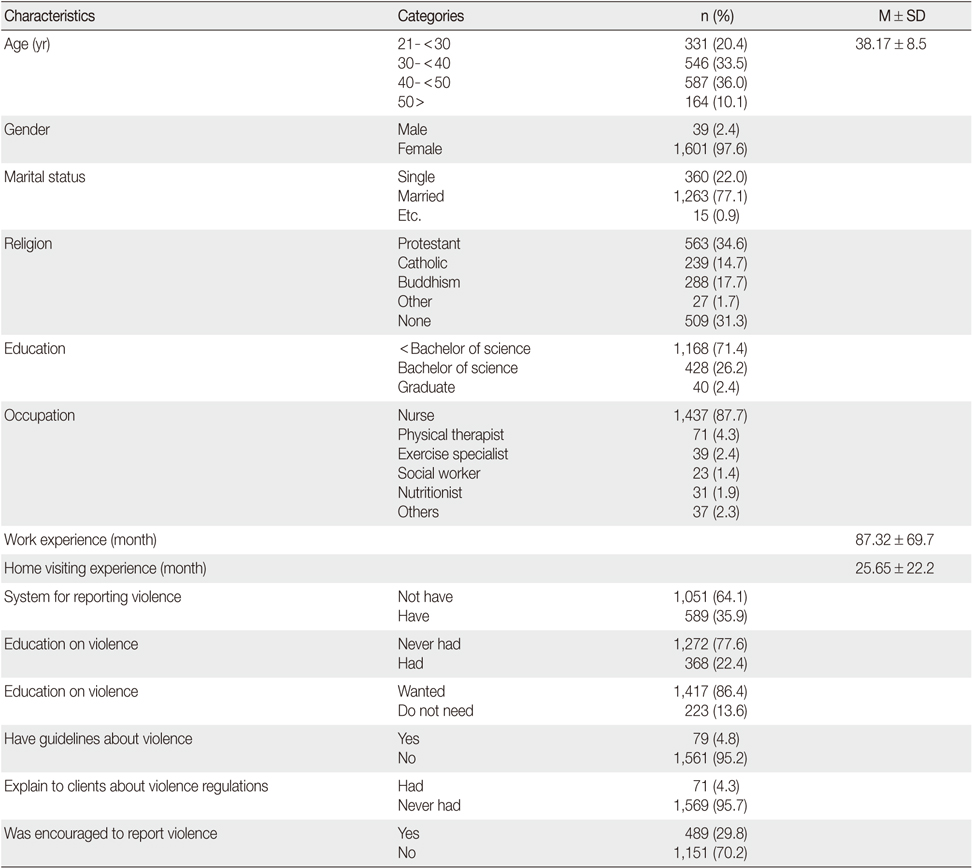
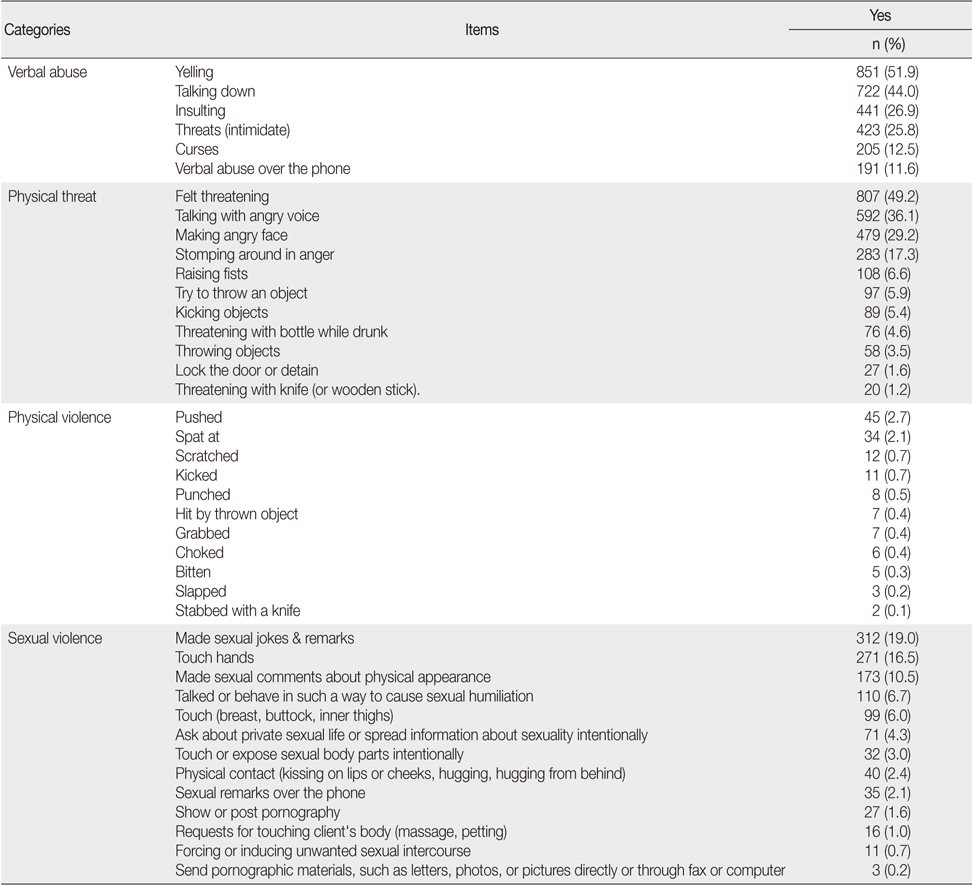
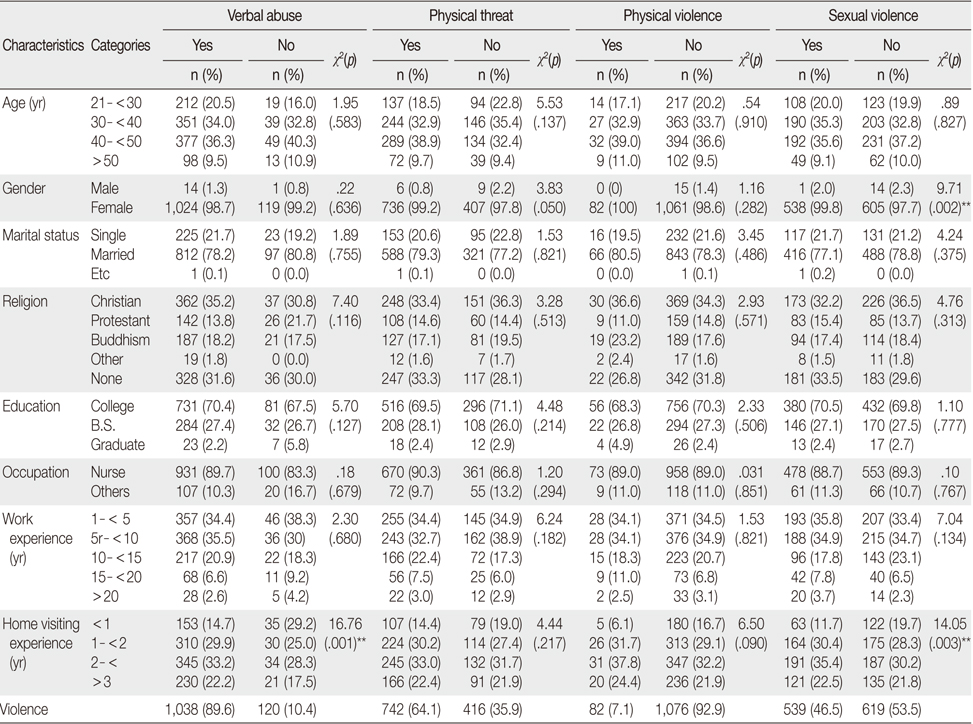
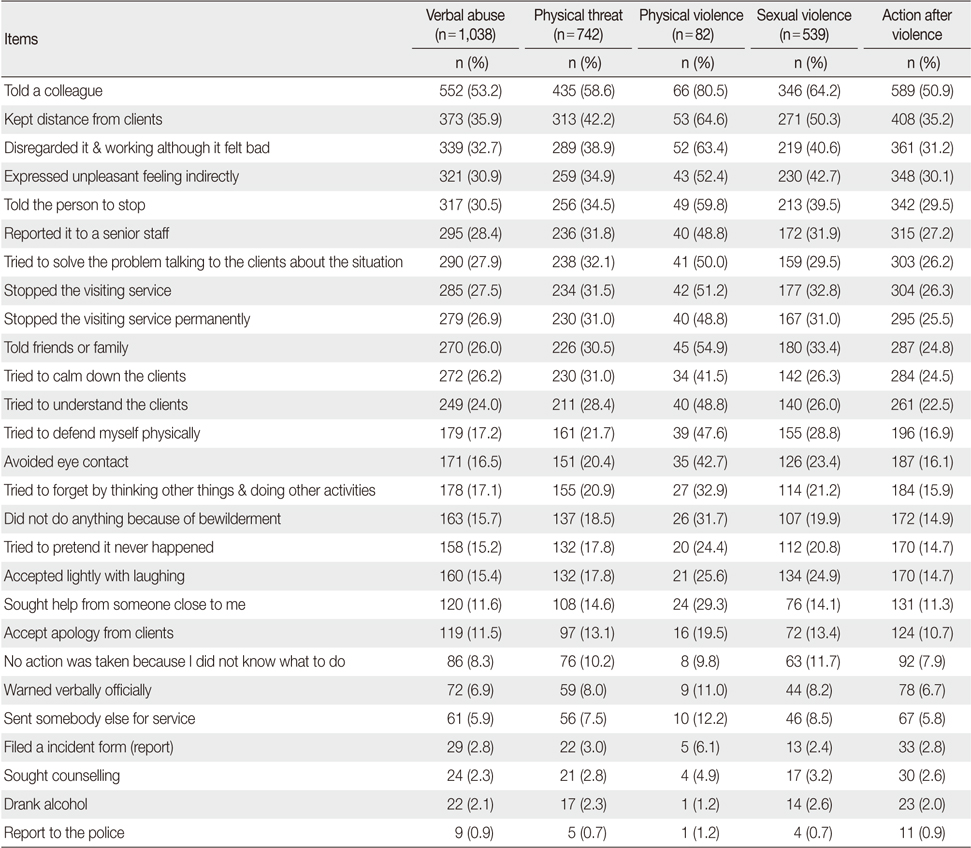
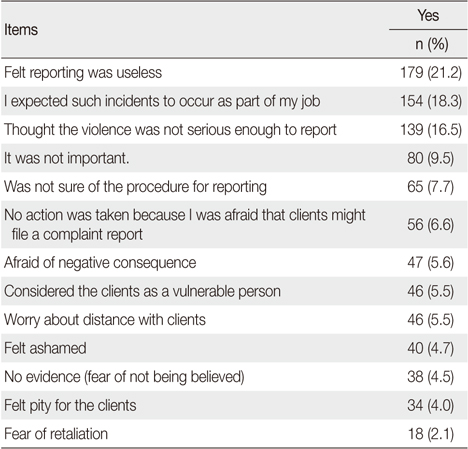
 Cite
Cite

